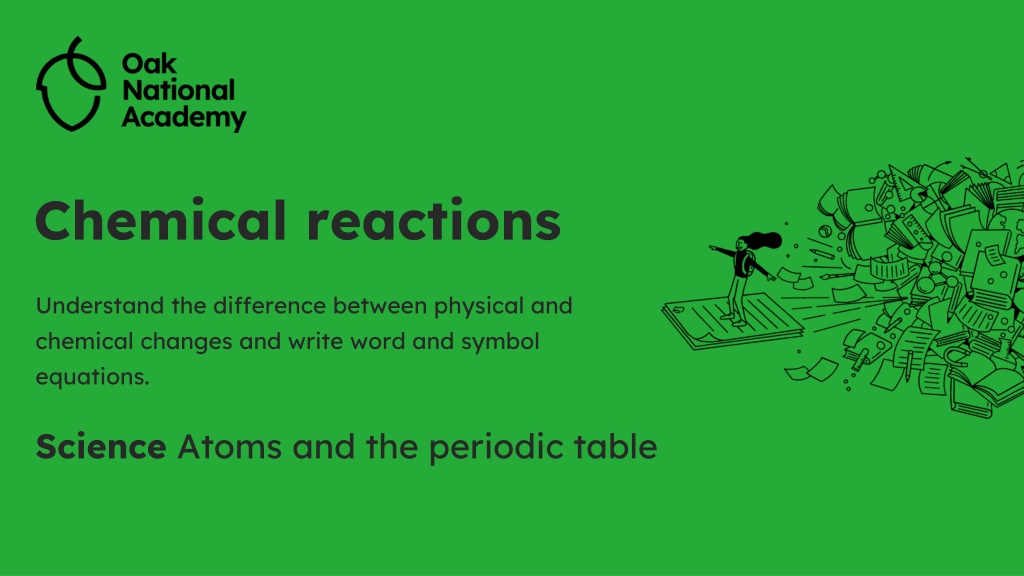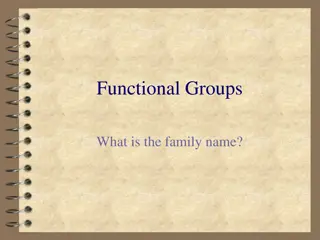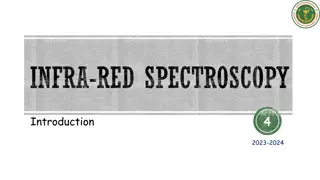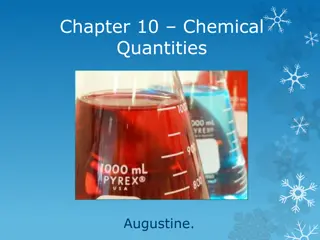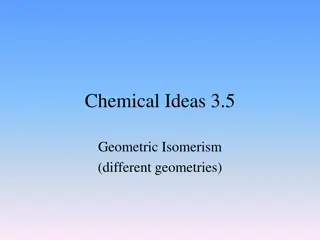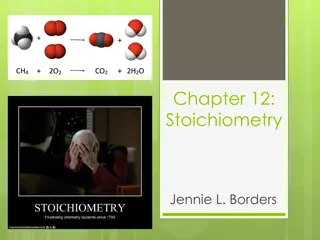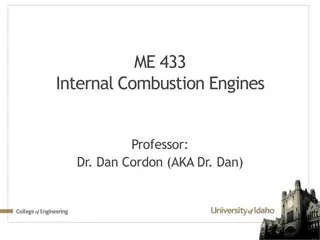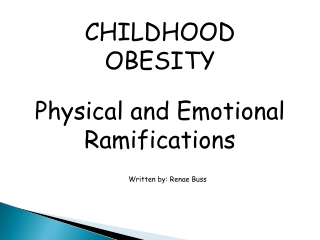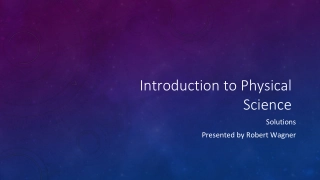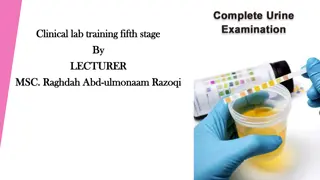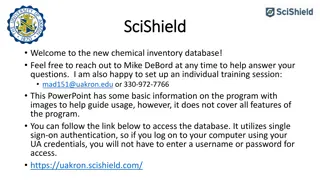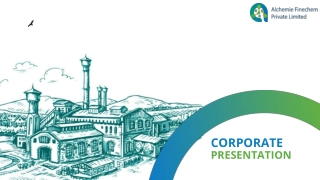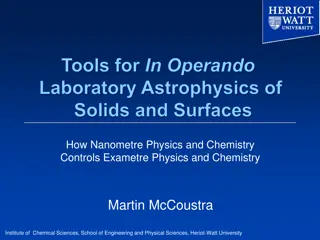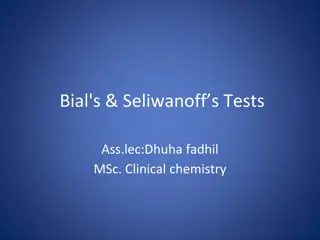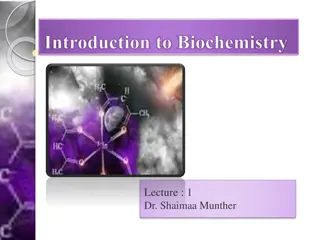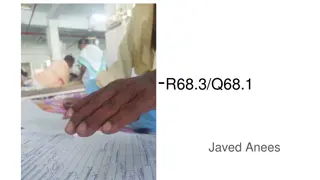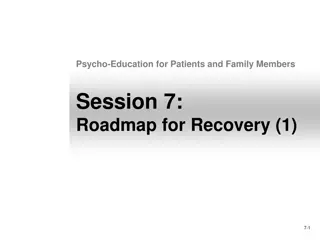Understanding Physical and Chemical Changes in Chemistry
Learn about physical and chemical changes in chemistry, including the differences between them, word and symbol equations, the periodic table of elements, and identifying chemical reactions through various signs and examples.
Download Presentation
Please find below an Image/Link to download the presentation.
The content on the website is provided AS IS for your information and personal use only. It may not be sold, licensed, or shared on other websites without obtaining consent from the author. Download presentation by click this link. If you encounter any issues during the download, it is possible that the publisher has removed the file from their server.
Presentation Transcript
Chemical reactions Understand the difference between physical and chemical changes and write word and symbol equations. Science Atoms and the periodic table
Keywords An element is a substance made from one type of atom. A chemical symbol is a one or two letter representation for an element. A substance s state is whether it is a solid, liquid or gas.
Lesson outline Chemical reactions Physical and chemical changes Equations Displacement reactions Decomposition reactions
Physical and chemical changes E Physical change Matter changes form or state. Chemical change A reaction that make new substances. melting ice cream breaking glass iron rusting food cooking Can you think of any others?
Physical and chemical changes E 6 signs of a chemical reaction: 1) fizzing (gas is produced) 2) colour change 3) temperature change 4) light produced 5) sound produced 6) smell produced It is usually difficult to turn your products back into reactants.
Physical and chemical changes C Which is the odd one out? milkshake mixing firework exploding water boiling physical change chemical change physical change
Physical and chemical changes E Why are these examples of chemical reactions? new product formed light produced gas produced (bubbles) new product formed gas produced (bubbles) colour change
Physical and chemical changes E How can you tell these are examples of chemical reactions? colour change light produced (flame)
C In which two test tubes has a chemical reaction taken place? A A B C B C
C True or false? Baking a cake is a chemical reaction. False True F T Justify your answer The product is the same as what you start with and you can easily obtain the butter, flour and sugar again. The product is different from what you start with and it is difficult to reverse the reaction. A B
C Which of the following is a chemical change? crushing a bag of crisps A sherbet fizzing on your tongue B filtering sand and water C
C Which of the following is a physical change? mixing watercolour paints A lighting a birthday candle B cooking a sausage C
Task 1 Physical and chemical changes P Stage 1: Mixing the chocolate chips into the dough. There are multiple stages to making cookies. Chemical or physical? Explanation For each stage, identify whether it is a physical or chemical change taking place and explain how you know. Stage 2: Separating dough into balls. Chemical or physical? Explanation Stage 3: Baking cookies in the oven. Chemical or physical? Explanation
Task 1 Answers P Stage 1: Mixing the chocolate chips into the dough. Chemical or physical? physical Explanation Chips would be easy to separate again. No new products (still dough and chocolate chips). No fizzing, colour change, temperature change, sound or smell.
Task 1 Answers P Stage 2: Separating dough into balls. Chemical or physical? physical Explanation No new products - still cookie dough, just in smaller pieces. It would be easy to return back to what you started with. No fizzing, colour change, temperature change, sound or smell.
Task 1 Answers P Stage 3: Baking cookies in the oven. Chemical or physical? chemical Explanation New product formed - baked cookies. Would be difficult to return back to what you started with. Colour change, smell produced, and bubbling.
Lesson outline Chemical reactions Physical and chemical changes Equations Displacement reactions Decomposition reactions
Equations E In a chemical reaction substances (reactants) react to make new substances (products). There are chemical reactions happening around us everyday. product reactants
Equations E Equations are a written representation of the process that occurs during a chemical reaction. reactant reactant product There are word equations using the substance names, iron + sulfur iron sulfide and symbol equations using the chemical symbols. Fe + S FeS
Equations E How to write word equations: 1) Identify which substances are being used - these are your reactants. 2) Identify which substances are being made - these are your products. 3) Put reactants names on the left and product names on the right. For example Magnesium reacts with oxygen to form magnesium oxide. magnesium oxygen magnesium oxide
C Fill in the blank in the word equation. Hydrogen reacts with oxygen to form water. ________ water hydrogen oxygen
C Fill in the blank in the word equation. Carbon, hydrogen and oxygen react to make ethanol. ________ ethanol carbon hydrogen oxygen
C Fill in the blank in the word equation. Aluminium oxide breaks down into aluminium and oxygen. ________ aluminium aluminium oxide oxygen
Equations E Symbol equations Instead of the names, we use chemical formulae. 2 H2 O2 2 H2O H O O O H Coefficients tell you the number of molecules. Subscript numbers tell you the molecule s chemical formula.
Equations E Diatomic molecules hydrogen (H2) H Some elements hang around in pairs, rather than as single atoms. oxygen (O2) O nitrogen (N2) N fluorine (F2) F chlorine (Cl2) Cl Watch out for these when balancing equations! bromine (Br2) Br I iodine (I2)
Equations E Symbol equations They need to be balanced. They must have the same number of atoms of each element on both sides of the equation. S S How many atoms of calcium are there? How many sulfur atoms? There is 1 calcium atom and 1 sulfur atom on both sides. This equation is balanced!
Equations E Hydrogen and chlorine are diatomic molecules (their atoms are found in pairs). Hydrogen reacts with chlorine to make hydrogen chloride. 2 Cl Cl Cl 2 How many molecules of HCl can I make?
Equations E Hydrochloric acid reacts with zinc to produce zinc chloride and hydrogen. Cl Zn 2 Cl Zn Cl 2 How many molecules of HCl do I need?
I do We do E C Balance the equation. Balance the equation. Hydrogen reacts with oxygen to produce water. Lithium reacts with chlorine to produce lithium chloride. 2 H2 O2 2 H2O Li Cl2 LiCl 2 2
C Magnesium reacts with oxygen to produce magnesium oxide. 2 Mg O2 MgO 2 How many molecules of magnesium oxide will I make?2
C Hydrogen reacts with nitrogen to produce ammonia. 3 H2 N2 2 NH3 How many molecules of hydrogen do I need?3
Task2 Equations P a) Write the word equation and add the symbols to the symbol equations. Reaction Word equation Symbol equation 4 __ + O2 2 K2O Na + __ NaF Potassium reacts with oxygen to make potassium oxide. Sodium reacts with fluorine to make sodium fluoride. C + O2 ___ Carbon reacts with oxygen to produce carbon dioxide. __ + Cl2 CaCl2 Calcium reacts with chlorine to make calcium chloride.
Task2 Answers P a) Write the word equation and add the symbols to the symbol equations. Reaction Word equation Symbol equation potassium oxide potassium + oxygen 4 __ + O2 2 K2O Na + __ NaF F Potassium reacts with oxygen to make potassium oxide. K sodium fluoride sodium + fluorine Sodium reacts with fluorine to make sodium fluoride. carbon dioxide CO2 C + O2 ___ carbon + oxygen Carbon reacts with oxygen to produce carbon dioxide. calcium chloride Ca __ + Cl2 CaCl2 Calcium reacts with chlorine to make calcium chloride. calcium + chlorine
Task2 Equations P b) Write the word equation and balance the symbol equations. Reaction Word equation Symbol equation Beryllium reacts with oxygen to produce beryllium oxide. _ Be + O2 2 BeO Hydrogen and bromine produce hydrogen bromide. Br2+ H2 _HBr Iron reacts with oxygen to make iron oxide. _ Fe + 3 O2 2 Fe2O3 Gallium reacts with sulfur to produce gallium sulfide. _Ga + _S Ga2S3
Task2 Answers P b) Write the word equation and balance the symbol equations. Reaction Word equation Symbol equation beryllium oxide Beryllium reacts with oxygen to produce beryllium oxide. beryllium + oxygen _ Be + O2 2 BeO 2 hydrogen bromide Hydrogen and bromine produce hydrogen bromide. hydrogen + bromine Br2+ H2 _HBr 2 Iron reacts with oxygen to make iron oxide. iron + oxygen iron oxide _ Fe + 3 O2 2 Fe2O3 2 3 4 gallium sulfide gallium + sulfur Gallium reacts with sulfur to produce gallium sulfide. _Ga + _S Ga2S3
Lesson outline Chemical reactions Physical and chemical changes Equations Displacement reactions Decomposition reactions
Displacement E Displacement reactions When one element takes the place of another in a compound. All displacement reactions follow the same format: A + BC AC + B + + B C A C
Displacement reactions E Example If magnesium is added to copper sulfate, magnesium and copper swap places to make magnesium sulfate and copper. Mg MgSO4 Cu CuSO4
I do We do E C When magnesium is added to copper sulfate, magnesium displaces copper to make magnesium sulfate and copper. When zinc is added to lead sulfate, zinc displaces lead to make zinc sulfate and lead. Write the word equation for this reaction. Write the word equation for this reaction. magnesium+ copper magnesium sulfate +copper zinc + lead zinc sulfate + lead sulfate sulfate
I do We do E C When magnesium (Mg) is added to copper sulfate (CuSO4), magnesium displaces copper to make magnesium sulfate (MgSO4) and copper (Cu). When zinc (Zn) is added to lead sulfate (PbSO4), zinc displaces lead to make zinc sulfate (ZnSO4) and lead (Pb). Write the symbol equation for this reaction. Write the symbol equation for this reaction. Zn + PbSO4 ZnSO4+ Pb Mg + CuSO4 MgSO4+ Cu
C If sodium (Na) is added to silver chloride (AgCl), a displacement reaction occurs. What are the reactants? AgCl + Na A NaCl + Ag B NaAg + Cl C
C If sodium (Na) is added to silver chloride (AgCl), a displacement reaction occurs. What are the products? AgCl + Na A NaCl + Ag B NaAg + Cl C
C How can you tell if an equation is displacement? The two reactants are added together to form one product. A There are always two reactants and two products. B Two elements in the reactants will have swapped places in the products. C
Task 3 Displacement reactions P a) Complete the word equations for these displacement reactions. i) calcium ___________ + lithium lithium chloride + calcium ii) sodium chloride + fluorine sodium fluoride + _________ iii) iron oxide + aluminium aluminium _________ + iron iii) silver ________ + copper copper nitrate + silver
Task 3 Answers P a) Complete the word equations for these displacement reactions. chloride i) calcium ___________ + lithium lithium chloride + chlorine calcium oxide ii) sodium chloride + fluorine sodium fluoride + _________ nitrate iii) iron oxide + aluminium aluminium _________ + iron iii) silver ________ + copper copper nitrate + silver
Task 3 Displacement reactions P b) displaces lead to make zinc nitrate Zn(NO3)2and copper Cu. When zinc Zn is added to copper nitrate Cu(NO3)2, zinc i) Write the word equation for this reaction. ii) reaction. Complete the symbol equation for this Zn + Cu(NO3)2
Task 3 Answers P b) zinc displaces lead to make zinc nitrate Zn(NO3)2and copper Cu. When zinc Zn is added to Copper nitrate Cu(NO3)2, i) zinc + copper nitrate zinc nitrate + copper Write the word equation for this reaction. ii) reaction. Complete the symbol equation for this Zn(NO3)2+ Cu Zn + Cu(NO3)2
Lesson outline Chemical reactions Physical and chemical changes Equations Displacement reactions Decomposition reactions
Decomposition reactions E Decomposition reactions When a substance breaks down into two or more smaller components. All decomposition reactions follow the same format: AB A + B + B A
